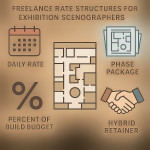Architect collaboration deals: write contracts that protect creative rights
Joint ventures between architects, engineers, artists and brand clients are booming. Yet many bright ideas are lost to vague paperwork. Learn how to draft collaboration contracts that shield your creative rights, keep fees flowing and let projects scale smoothly worldwide.
Why airtight collaboration contracts matter

Shared authorship pushes boundaries—think immersive pavilions, eco-smart interiors and branded pop-ups. Unfortunately, informal emails rarely clarify who owns sketches, BIM models or the stunning render that wins the pitch. Without a clear agreement, scope creep and IP conflicts delay construction, inflate legal bills and erode reputations.
Collaboration trends driving new risks
- Rapid digital workflows: Cloud BIM hand-offs mean multiple parties touch the same file. Misattributed edits spark ownership debates.
- Cross-border teams: Differing copyright laws make “work made for hire” clauses unreliable abroad.
- Content-hungry marketing: Clients want to repost process videos on TikTok; architects expect attribution on every clip.
Seasoned studios now treat the contract as a design tool—one that safeguards creativity while enabling innovation.
Core clauses that protect an architect's creative rights
1. Clear ownership versus licence
Default law often grants authorship to the creator, not the payer. Spell out who owns drawings, 3D assets and photographs, then list any licence granted to partners. Typical approach:
- Architect retains copyright.
- Client receives a non-exclusive, worldwide licence to construct, operate and market the project.
- Third-party reuse—such as a future venue retrofit—requires fresh fees.
2. Moral rights & credit
In many jurisdictions, architects have an inalienable right to be named and to preserve the integrity of their work. State that:
- Visible credit lines must appear in press releases, social media captions and onsite plaques.
- No alteration may distort the original concept without written approval.
3. Scope of permitted reuse
Clarify whether collaborators may adapt floorplans for another site, licence renders to stock libraries or mint NFTs. A narrow scope today avoids royalty rows tomorrow.
4. Royalty and profit-share mechanics
If designs are turned into retail products—furniture, VR tours, coffee-table books—state royalty percentages, payment frequency and audit rights. Link variable income to transparent project-phase metrics rather than vague “net profits.”
5. Termination & buy-out
Projects stall. Include triggers (e.g., 120 days of non-payment) and a formula for buying out rights so each party can pivot without litigation.
Negotiation workflow that keeps creativity central
Step 1 – Map IP during the concept sprint
Create a shared matrix listing every deliverable: sketches, parametric scripts, mood boards, site photos. Assign provisional ownership before any file leaves your server.
Step 2 – Deploy a concise term sheet
Summarise fees, schedules and IP rules on two pages. Busy developers approve faster, leaving lawyers to polish fine print.
Step 3 – Align legal language with marketing goals
Marry contract rights to your visibility strategy. If you plan a case study on leading collaboration jobs for spatial designers, reserve the freedom to publish images once the NDA lifts.
Step 4 – Use version control
Store draft clauses in your BIM repository. Version IDs prevent the “wrong PDF” problem that has sunk many deals.
Step 5 – Final sign-off & escrow
Release layered files only after e-signatures and first-stage payments clear. Simple escrow tools automate this gate.
Template snapshot: AIA B101 vs. bespoke collaboration contract
| Clause | AIA B101 Standard | Bespoke Collaboration Focus |
|---|---|---|
| Copyright | Architect retains; client licence for project only | Adds royalty splits for derivative products |
| Moral Rights | Not explicit | Guarantees credit & no distortion |
| Digital Assets | Models included in Instruments of Service | Defines BIM file tiering & reusable scripts |
| Marketing Use | Silent | Enables social media & award entries with consent |
| Dispute Resolution | Mediation, then arbitration | Fast-track arbitration within 30 days |
Cross-border collaborations: special considerations
- Choice of law: Opt for a jurisdiction that recognises moral rights, or stipulate arbitration rules.
- Currency risk: Peg royalties to a stable index and include exchange-rate adjustment windows.
- Data transfer: Add GDPR-compliant clauses if servers host user walk-through data.
When managing teams across time zones, pair legal rigour with operational tools highlighted in remote BIM management guides.
Future-proof your rights with sustainable partnerships

Eco-driven projects invite material suppliers, environmental consultants and brand sponsors into the IP mix. Embed “green attribution” clauses referencing materials listed in your ethical sourcing registry. You gain recognition whenever recycled steel specs make headlines.
Quick quiz: are your contracts collaboration-ready?
FAQ
- Can I reuse collaboration drawings on a new site?
- Only if your contract grants a transferable or additional-site licence. Otherwise, negotiate fresh terms and compensation.
- Do I need separate contracts for visuals and built work?
- Yes. Treat renderings, AR walk-throughs and construction documents as distinct assets with tailored licence scopes.
- How do royalties work when a client sells branded furniture derived from my design?
- Include a royalty clause pegged to wholesale revenue, with quarterly reporting and audit rights to verify sales figures.
Take the next step
Draft a two-page term sheet today, then refine it into a full contract before your next pitch. Your ideas deserve legal scaffolding as sturdy as your structures. Need more visibility? Update your architect bio for SEO and watch qualified leads grow.











